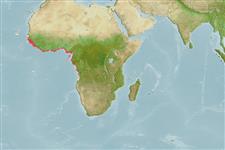Classificação / Names
Common names from other countries
Referência principal
Tamanho / Peso / Idade
Max length : 45.0 cm TL macho/indeterminado; (Ref. 5476); common length : 30.0 cm TL macho/indeterminado; (Ref. 5476)
Ambiente
; marinhas; estuarina bentopelágico; intervalo de profundidade 10 - ? m (Ref. 2683)
Clima / Intervalo
Tropical, preferred 27°C (Ref. 107945); 15°N - 13°S
Distribuição
Descrição breve
Espinhos dorsais (total): 14; Raios dorsais moles (total): 16; Espinhos anais 3; Raios anais moles: 7. Diagnosis: body oblong, rather deep; dorsal profile strongly convex at level of dorsal-fin origin; snout at least as long as eye diameter; mouth oblique; lips very thick; chin with 4 pores, but without median pit; dorsal fin long; second anal fin spine the longest and stoutest; caudal fin rounded; ctenoid scales covering body and head (except snout) and interradial membranes of soft parts of dorsal and anal fins (Ref. 57395).
Coloration: uniformly brown, more or less dark; young individuals often with lighter spots on flanks (Ref. 57395).
Categoria na Lista Vermelha da IUCN (Ref. 115185)
Ameaça para o homem
Harmless
Utilização humana
Pescarias: espécies comerciais
Mais informação
ReferênciasAquaculturaPerfil para aquaculturaEstirpesGenéticaFrequência dos alelosHereditariedadeDoençasProcessamentoMass conversion
ColaboradoresFotografiasStamps, CoinsSonsCiguateraVelocidadeTipo de nataçãoÁrea branquialOutras referênciasCérebrosVisão
Ferramentas
Relatórios especiais
Descarregue XML
Fontes da internet
Estimates of some properties based on models
Phylogenetic diversity index
PD50 = 0.5000 many relatives (e.g. carps) 0.5 - 2.0 few relatives (e.g. lungfishes)
Nível Trófico
3.7 ±0.6 se; Based on size and trophs of closest relatives
Resiliência
Médio, tempo mínimo de duplicação da população 1,4 - 4,4 anos (Preliminary K or Fecundity.)
Vulnerabilidade
Moderate vulnerability (37 of 100)
Categoria de preço
